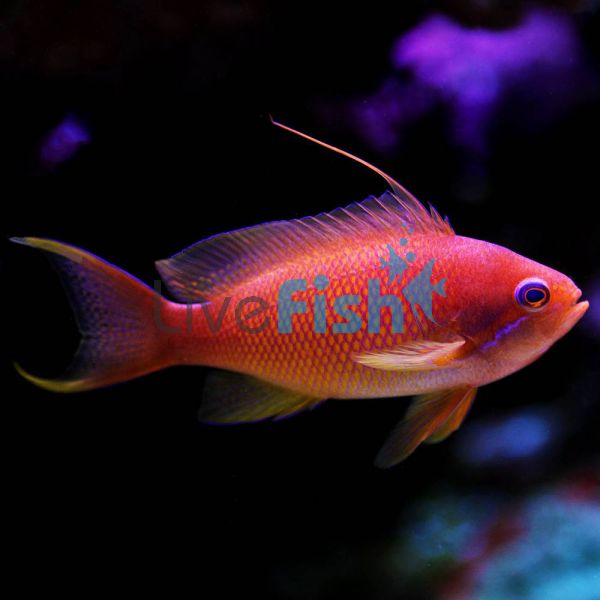Male Lyretail Anthias - Large
The males have different shades of bright red colouration, while the female Lyretail Anthias tends to be more of an orange colour.
Anthias are shoaling fish and so keeping a group of them in a species-specific tank can provide a very impressive visual effect. They also mix well with other species and so are also suited to reef aquarium setups.
Male Anthias Lyretail
The males have different shades of bright red colouration, while the female Lyretail Anthias tends to be more of an orange colour.
Anthias are shoaling fish and so keeping a group of them in a species-specific tank can provide a very impressive visual effect. They also mix well with other species and so are also suited to reef aquarium setups.
Male Lyretail Anthias are best kept alone or with several females. All Anthias species are hermaphroditic and in the wild usually, a male will have a harem of 5 to 10 females. If a dominant male dies, then the largest female of the group will usually develop into a male to take his place.
In the wild, these fish live around Fiji and Indonesia.
Tank Recommendations for Lyretail Anthias
These Anthias do best when kept in a group and housed in a species-specific aquarium of at least 473 litres (125 gallons) in size.
These fish generally occupy the middle of the aquarium and doesn’t need a specific aquarium setup. It appreciates the availability of several hiding places. Live rock is ideal for this as it allows you to arrange it so that there are caves and crevices for them to hide amongst.
Suitable Tank Buddies
The Lyretail Anthias is a great choice for a reef tank as it is a very sociable fish that will mix with most other fish that aren’t likely to eat it. Keeping them in a group of the same species works well with these fish too.
Usually Compatible
With other species of fish, the Anthias generally won’t have any problems. If you are keeping a group of these together then it’s best to try and have 5 to 10 females to each male.
Sometime Compatible
Be cautious if keeping Lionfish, Scorpionfish, Eels, Groupers and large Wrasses and Triggerfish with Anthias in case they try to eat them, especially when smaller. Only keep multiple male Lyretail Anthias together in very large aquariums and ensure that there are also plenty of females.
Rarely Compatible
Don't keep Seahorses and Pipefish shouldn’t with Anthias as they will get out-competed for food being slower swimmers. Then Sharks, Rays and Groupers should also be avoided as they will happily eat the Anthias.
Feeding Your Lyretail Anthias
In the wild these fish feed primarily on zooplankton. In the aquarium, you should feed them a diet of frozen or live mysis and brine shrimps. You can also feed them live copepods and rotifers which you can introduce to the aquarium before adding the fish. Then you can regularly top up the supplies to ensure that they have plenty to eat.
You may also be able to get them to eat some flake food which will help to make their diet more varied, but a steady supply of live foods will keep their content.
| Scientific Name | Pseudanthias squamipinnis |
|---|---|
| Care Level | Moderate |
| Common Names | The Sea Goldie, Orange Basslet, Lyretail Coralfish, Lyretail Anthias, Lyretail Fairy Basslet, Orange Fairy Basslet, Orange Seaperch, Scalefin Basslet, Scalefin Fairy Basslet and Scalefin Anthias |
| Diet | Carnivore |
| Fish Family | Serranidae |
| Lifespan (years) | 4 |
| Max. Length (cm) | 15 |
| Min. Tank Volume (l) | 473 |
| Origin | Fiji & Indonesia |
| Reef Safe | Yes |
| Sociability | Semi-aggressive |
| Water Conditions | 22-28° C, dKH 8-12, pH 8.1-8.4, sg 1.020-1.025 |




